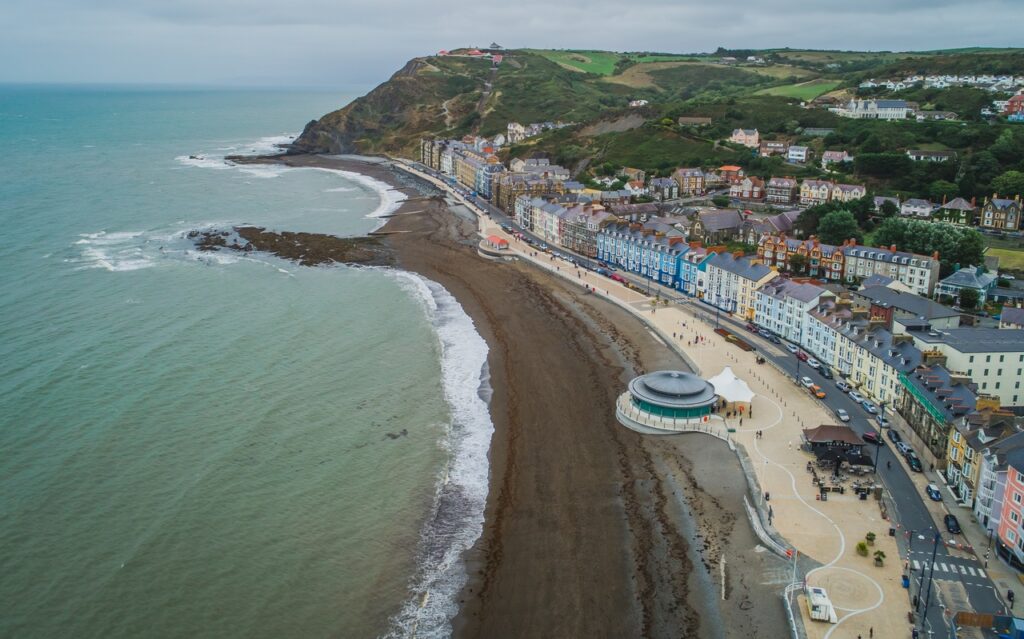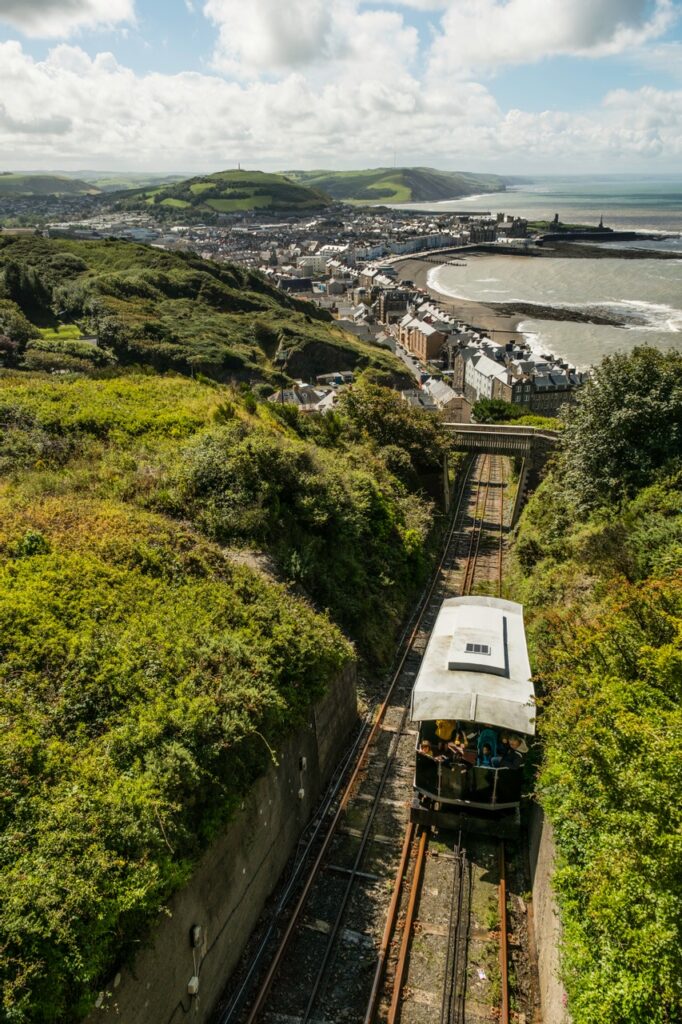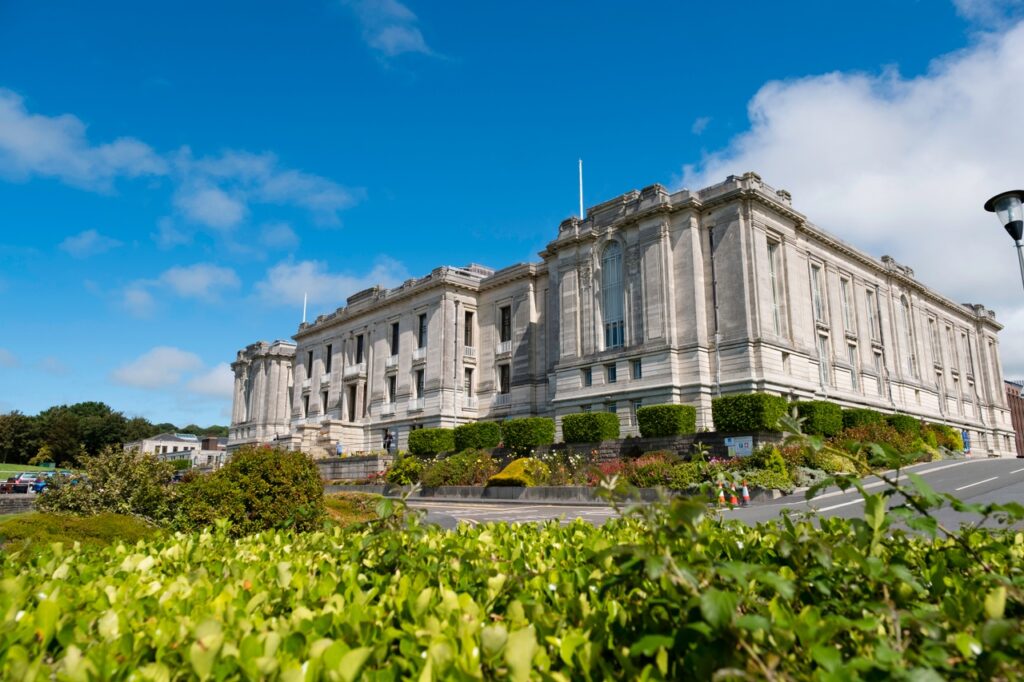Aberystwyth

ABERYSTWYTH has been described as the culture capital of Wales. Home to The National Library, University and an outstanding Arts Centre with concert hall, cinema, large exhibition space, plus a café and design shop.
The town, largely regarded as the unofficial capital of mid Wales, is nestled between three hills and two beaches and hosts some castle ruins, a pier and a harbour. The surrounding hills hold the visible remains of an Iron Age fort and also a monument to Wellington and, once climbed, offer stunning views of Cardigan Bay.
Ceredigion Museum, housed in the Edwardian Coliseum Music Hall, has displays focusing on agriculture, seafaring and lead mining.
Being a University town, Aberystwyth is full of cafés, bars, eating places and a wide range of specialist shops. There are market halls at the top of Great Darkgate Street which expand into the street every Wednesday and Saturday, and a Farmers Market is held on the third Friday of the month.
The mile-long Victorian promenade at Aberystwyth is the world’s longest and largest and almost anywhere you are in the town you can look up and see Constitution Hill, home to the Rheidol cliff railway.

The history of modern Aberystwyth started in 1277 with the granting of a Royal Charter and the building of the castle on the current site. Aberystwyth Castle was partly destroyed on the orders of Cromwell after the New Model army defeated The Royalists in 1654.
Aberystwyth, with its Georgian seaside charm, is an ideal base to explore the landscapes of Ceredigion, the Cardigan Bay coast and the Cambrian Mountains.
The Aberystwyth seafront and streets still retain much of their Georgian and Victorian character, with bow windows, colonnaded doorways and elegant proportions.
To see where the earliest inhabitants of Aberystwyth lived, visit Pendinas hillfort, just to the south of today’s harbour. It overlooks the town and most of Cardigan Bay.
Authorised by an 1897 Act of Parliament and opened in 1902, the Vale of Rheidol Railway’s locomotives and carriages, some of which are still in use today on the line, were built by the Great Western Railway.
A trip inland on the narrow gauge, steam railway is the best ways to see the spectacular valley landscape and waterfalls of the Rheidol valley between Aberystwyth and Devil’s Bridge. There are special excursions too, with music, food and themed trips for Christmas and Halloween.
There is a cafe at the summit and the famous Camera Obscura. The present building is a recreation of the Victorian original. As the carefully-balanced mirror revolves, detailed views of the surrounding countryside are thrown onto the table in the centre of the building.
On the same day that the railway station opened – Good Friday 1869 – so did Aberystwyth’s Royal Pier – the first in Wales. It was 800 feet long (approximately 248m) but was damaged by severe storms the following year.
Aberystwyth is justifiably famous for its glorious sunsets, spectacular winter storms and starling murmurations. From autumn through to early spring, the birds swirl in harmony across the evening sky before coming into roost under the pier each night.
Overlooking Aberystwyth town is the imposing building that houses the National Library of Wales. It may have over five million books on its shelves, but it’s nothing like an ordinary library – you can’t even take out a borrowed book.
It’s the place to get an insight into Welsh culture through film, sound, art, maps and documents, and there are exhibitions, talks, concerts and behind-the-scenes guided tours. If you’ve got Welsh ancestry, you can trace your roots there too.
The National Library complex is home to the Centre for Advanced Welsh and Celtic Studies and the base of the Royal Commission on the Ancient and Historic Monuments of Wales. It incorporates the National Screen and Sound Archive of Wales, one of six British regional film archives.
Established in 1907, the Library is a Welsh Government-sponsored body. According to Cyril Evans, the Library’s centenary events co-ordinator, “The library is considered to be one of the world’s greatest libraries, and its international reputation is certainly something that all Welsh men and women are intensely … proud of”.

Aberystwyth Arts Centre is a little further up Penglais Hill, on the University’s main campus. The centre hosts world-class performers and artists in its theatres, galleries and studios and includes exhibition spaces, a theatre, cinema and concert hall as well as artists’ studios, book and gift shops.
The Aberystwyth University School of Art, close to the centre of the town, has a collection of fine and decorative art from the 15th Century to 21st Century contemporary art, and has changing exhibitions from its collections as well as graduate shows.
The University hosts seven thousand students, ensuring it vibrant atmosphere throughout the year.
The Ceredigion Museum and Tourist Information Centre is a great place to start any exploration of Ceredigion. As well a great collection of traditional Welsh furniture, costume and artefacts illustrating rural domestic and business life, the Museum has a large collection of art and a lively programme of activities and events.
The seafront hosts attractive Victorian and Edwardian buildings mostly four or five stories high. The wide promenade protects the buildings from the revenge of the Irish Sea and offers space to sit, soak up the sun and view the surrounding hills and mountains which in winter are often covered in snow. On a clear day, you may see the tallest mountain in Wales, Snowdon.
The harbour was once one of the busiest in Wales and is fed by the rivers Ystwyth and Rheidol. Geographically, Aberystwyth may be considered isolated from the rest of Wales but is now the centre of local rural life and visited by many to sample the numerous cafes, bars and restaurants, including Chinese, Indian, Italian and Mediterranean cuisine.
Long before the Normans began their castle-building program, Iron Age settlers used the hilltop called Pen Dinas to build a huge fortification, which still dominates the skyline as you approach Aberystwyth from the south.
The first Norman castle was a ringwork affair castle, built in the early 12th Century. Inevitably, the earth and timber defences proved too vulnerable and a new site was chosen for a castle in Aberystwyth itself. This time it was the Welsh, led by Llywelyn the Great who built the castle and it changed hands several times before finally became useless against new weapons. The last castle built at Aberystwyth once ranked among the greatest in Wales but today, lies entirely ruined and offering only a faint image of its once impressive past.

As early as the 14th Century, the concentric fortress began to decay. By 1343, large portions of the main gateway and drawbridges, and the outer bailey were falling down. The closeness of the castle to the pounding sea causing much of the decay.
In 1404, Owain Glyndwr seized the crumbling fortress. Within a few years the English regained possession but after 1408, Aberystwyth Castle lost its strategic value to the monarchy, and only minor repairs were attempted.
During the Civil War, the castle became a victim of Oliver Cromwell’s ruthless policy of slighting because the garrison sided with the king, Charles I. Most of the castle stone was pilfered by locals to build their homes.
Cymdeithas yr Iaith Gymraeg (Welsh Language Society) held their historic first protest on Trefechan Bridge in Aberystwyth, on February 2, 1963. The first independent Welsh Evangelical Church was established in Aberystwyth.
Aberystwyth hosted the National Eisteddfod in 1865, 1916, 1952 and 1992.
On March 1, 2005, Aberystwyth was granted Fairtrade Town status.
The all-organic dairy unit of Rachel’s Organic is based in Glan yr Afon, and is the largest private sector employer in Aberystwyth.
North Parade, Aberystwyth, was reported to be the most expensive street in Wales in 2018, based on property prices.
As well as having two cinemas and a golf course, the town’s attractions include the Parc Penglais nature reserve and the Ystwyth Trail cycle path.
Aberystwyth RFC is the local rugby union club and acts as a feeder club to professional side Scarlets. Aberystwyth Town FC is a semi-professional football club that was formed in 1884. The team compete in the Cymru Premier, Wales’s top division.

The TV series Hinterland [Y Gwyll] was filmed in and around Aberystwyth from 2013 to 2016 and the area is promoted as an opportunity for tourists to visit filming locations.
One of Aberystwyth’s more recent famous exports is actor Taron Egerton, star of Eddie the Eagle, Kingsman – The Secret Service and smash hit film Rocketman for which he won a Golden Globe.
Egerton’s family moved to Aberystwyth when he was in his early teens and he began his acting career with the Aberystwyth Arts Centre’s youth theatre group before being accepted into RADA aged 19. He regularly heads home to catch up with family and friends and claims “Wales is absolutely where my heart is”.
Back to HOME PAGE